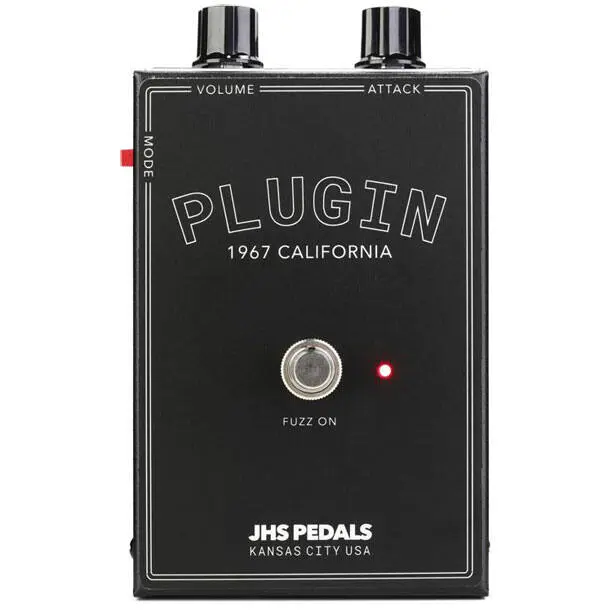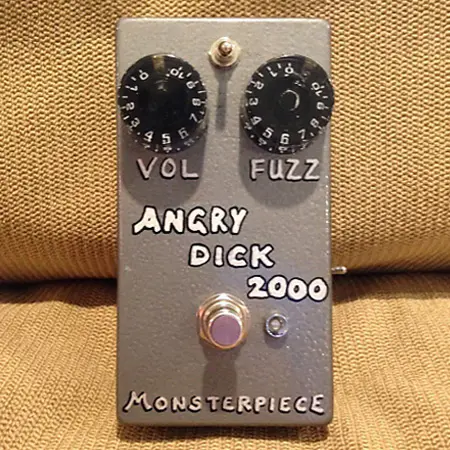Welcome to our regularly updated guide to the best Jordan Boss Tone clones and evolutions! If you are interested in a more in-depth about fuzz, you owe it to yourself to read this article about all the legendary fuzz circuits and their variants.

List updated on June 6th, 2023
The Jordan Boss Tone came onto the scene in California in 1966 and was one of the first guitar effects (and the first fuzz) that could be plugged right into your guitar jack (yep, it wasn’t originally a pedal!). It had an on/off switch that needed to be toggled by hand to activate the effect.
Although other fuzz pedals like the Maestro FZ-1 and the Tone Bender were already around, the Boss Tone became so popular that its sound ended up becoming iconic for the sound of the ’60s, found in evergreen recordings by bands like early ZZ Top and Norman Greenbaum, who famously used it in the guitar riff of his hit single Spirit In The Sky.
The Original Jordan Boss Tone
The circuit of the Jordan Boss Tone was incredibly simple – just two transistors and two capacitors – and tweaking its two knobs (named Attack and Volume) would produce a variety of fuzzy tones with long sustain ranging from the singing and smooth to the piercing and hissy, often carrying a hint of a lower octave.
A common critique of the Boss Tone circuit is its lack of low end, but this is also what makes the Boss Tone great for stacking with boosts, EQs or drives, and why it remains in the arsenal of modern players like Dan Auerbach today.
Jordan Electronics, the company that manufactured the Boss Tone has a fascinating story dating back to the ’20s – you can hear it in the video below by The JHS Show.
Jordan released several versions of the Boss Tone in its original form factor, all with slight variations in tone. You can hear a shoot-out of the various versions here.
The Best Jordan Boss Tone Clones and Evolutions
For mysterious reasons probably related to taste and marketing, after the initial “boom” the Boss Tone didn’t maintain the level of popularity other vintage fuzz circuits like the Big Muff or the Fuzz Face have enjoyed. Nonetheless, it is still considered a unique fuzz, and although it now exists in pedal-shaped reissues released by the original company, several other builders big and small have been trying to replicate, perfect or develop its sound through their own releases.
Here’s the list of our favorite Boss Tone Clones and Evolutions, starting with the reissue by Mahoney, current owner of Jordan Electronics.
1. Mahoney Buzz Tone

$129 | Click title for video. Check for availability on Reverb.
Mahoney is the company that bought Jordan Electronics and owns the original circuit. Their Buzz Tone is a faithful recreation of what’s known as the “Nashville” variation of the Jordan Boss Tone, which was the final version and the longest in production. The Buzz Tone retains its smoother voice with a hint of low-octave harmonics. The same circuit is also available in the original plug-in form factor for $40 less.
2. Voodoo Lab Superfuzz

$129 | Click title for video. Buy it on Reverb.
This is not actually a Univox Super Fuzz, it’s a Boss Tone clone! Voodoo Labs adds Tone and Resonance knobs to shore up any tonal shortcomings of the original circuit and pumps up the output volume to bring the circuit into the modern era.
3. KMA Machines Fuzzly Bear
Germain builders KMA are never short on creative fuzz ideas. For their Fuzzly Bear, they started off with a Boss Tone, but brought back the low end and added a bias control for sputtering, gated chaos. Like many good ’60s-style fuzz circuits, the Fuzzly Bear will clean up with your volume knob and turn into a crunchy overdrive at lower levels. V2 adds updated electronics, top-mounted jacks, and a soft switch upgrade for the footswitch.
—
—
4. JHS Pedals Plugin

$179 | Click title for video. Buy it new on Sweetwater or Thomann or look for deals on Reverb.
JHS pedals already had a limited edition plugin recreation of the Boss Tone, called Buzz Tone (obviously nearly impossible to find), so it wasn’t too complicated for the Kansas City builder to rework the circuit into a stompbox format, although this circuit – part of their Legends of Fuzz series – features an added Mode switch which gives you two slightly different tonal flavors.
5. Electro-Harmonix Satisfaction

$69 | Click title for video. Buy it new on Sweetwater or Thomann or look for deals on Reverb.
A bit of a red herring of a name (Keith Richards used a Mestro FZ-1 on Satisfaction), the Satisfaction Fuzz is nonetheless tuned to perfectly capture that 60s honky, buzzy flavor. 70 dollars and two knobs are all you need to go back in time to the golden age of fuzz – with added true bypass. The Gear Page reports that it’s a “Jordan Boss Tone clone minus the bass+ cap and clipping diodes.” The 2023 Satisfaction Plus delivers a wider palette of tones.
6. Gooby Bag of Dicks Fuzz

~$139+ | Click title for video. Check for availability on Reverb.
A Boss Tone-inspired mini fuzz that, instead of a volume or gain or “fuzz” knob, features a “Warning” knob that controls the voltage fed to the circuit. When turned to the max, this knob will make the pedal sound like the best possible version of the Jordan Boss Tone. However, turning it down will progressively “starve” the circuit, affecting that tone in various ways: a velcroy effect at first; a more pronounced breakup at even lower levels; and then, around 1 o’clock, the introduction of the resemblance of a sub-octave, that becomes more pronounced as you keep turning the knob anti-clockwise.
7. Gooby Bag of Dicks Fuzz

~$350+ | Click title for video. Check for availability on Reverb.
An older, out-of-production, hand-made clone of the Jordan Boss Tone fuzz that’s still sought after for its unique tonal flexibility and quality constructions, with used units selling for a small fortune on Reverb. It can sound like an Octavia at lower fuzz settings and get close to a fuzz face at medium ones, without losing the Bossaround’s typical long sustain and cutting edge.
8. Bearfoot FX Gnarwahl Plus

~$199 | Click title for video. Check for availability on Reverb.
St. Louis’ Bearfoot FX made two models inspired by the Boss Tone, both using Silicon clipping diodes: the now discontinued Burgundy Bosshorsne and the more recent (but also hard to find) Gnarwahl, which is available in a compact case with just three knobs and one footswitch or in “Plus” version, hosted larger case (like in this picture) with six knob and two footswitches. Explosive and, as the name suggests, as gnarly as it gets, the Gnarlwahl Plus is one of the most flexible Boss Tone evolutions, thanks to controls like “Hair” and “Balls” and an extra footswitch to switch between two fuzz settings.
9. Basic Audio Texsur

~$200 | Click title for video. Buy it on Reverb.
As is custom with Basic Audio pedals, the Texsur stays true to the past while adding modern features. Tone and Starve controls allow for versatility and gnarly gating. An octave-up toggle switch brings out that iconic ring mod-esque octave sound. Combining the octave-up with the Bias control introduces a whole world of gating fuzz possibilities.
10. BLAMMO! Jordan Bosstone

~$150 | Click title for video. Check for availability on Reverb.
Although this BLAMMO! Electronics version of the Boss Tone is not a radical departure from the original, it’s also not a faithful replica, delivering a more midrangey and textured tone reminiscent of two transistor fuzzes like the Fuzz Face. Just like the latter, it cleans up much better when you turn down your guitar’s volume. The tone is also slightly affected by the fact that it uses asymmetrical diode clipping, with its signature even-order harmonics, compared to the symmetrical clipping of the original, delivering a not-too-familiar vintage sound with a modern consistency.
11. Monsterpiece Angry Dick 2000

~$150 | Click title for video. Check for availability on Reverb.
Let’s just ignore the name and focus on how this hand-built pedal sounds. And it sounds fantastic! A faithful recreation of the original California”v1 Boss Tone and the later Nashville-made models, beloved by lap steel players. A toggle allows the user to switch between the buzzy, honky California mode and the more bass heavy, compressed Nashville mode. See also the (sigh) “Double Dick” version that includes one of each circuit with separate footswitches for stacking.
12. JHS Buzz Tone

~$199 | Click title for video. Check for availability on Reverb.
This is a faithful clone of the Boss Tone in the same plug-in format as the original, launched by JHS for the launch of their 2021 video episode fully dedicated to that circuit. There are only 100 units on the market, and currently sell for around $200.

























